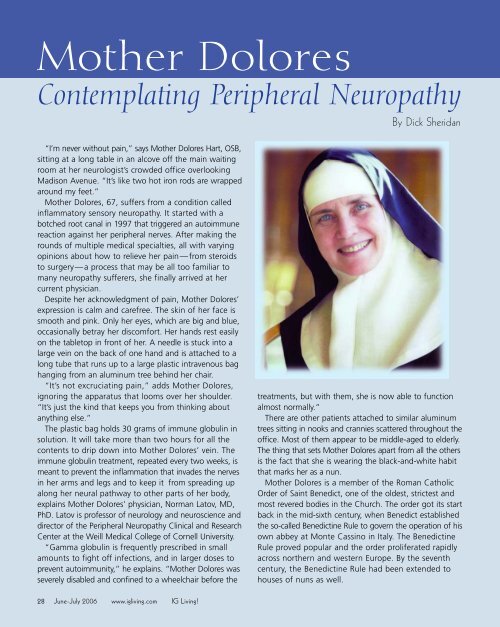Mother Dolores Hart Contemplating Peripheral Neuropathy - IG Living
Mother Dolores Hart Contemplating Peripheral Neuropathy - IG Living
Mother Dolores Hart Contemplating Peripheral Neuropathy - IG Living
- No tags were found...
You also want an ePaper? Increase the reach of your titles
YUMPU automatically turns print PDFs into web optimized ePapers that Google loves.
<strong>Mother</strong> <strong>Dolores</strong><strong>Contemplating</strong> <strong>Peripheral</strong> <strong>Neuropathy</strong>By Dick Sheridan“I’m never without pain,” says <strong>Mother</strong> <strong>Dolores</strong> <strong>Hart</strong>, OSB,sitting at a long table in an alcove off the main waitingroom at her neurologist’s crowded office overlookingMadison Avenue. “It’s like two hot iron rods are wrappedaround my feet.”<strong>Mother</strong> <strong>Dolores</strong>, 67, suffers from a condition calledinflammatory sensory neuropathy. It started with abotched root canal in 1997 that triggered an autoimmunereaction against her peripheral nerves. After making therounds of multiple medical specialties, all with varyingopinions about how to relieve her pain—from steroidsto surgery—a process that may be all too familiar tomany neuropathy sufferers, she finally arrived at hercurrent physician.Despite her acknowledgment of pain, <strong>Mother</strong> <strong>Dolores</strong>’expression is calm and carefree. The skin of her face issmooth and pink. Only her eyes, which are big and blue,occasionally betray her discomfort. Her hands rest easilyon the tabletop in front of her. A needle is stuck into alarge vein on the back of one hand and is attached to along tube that runs up to a large plastic intravenous baghanging from an aluminum tree behind her chair.“It’s not excruciating pain,” adds <strong>Mother</strong> <strong>Dolores</strong>,ignoring the apparatus that looms over her shoulder.“It’s just the kind that keeps you from thinking aboutanything else.”The plastic bag holds 30 grams of immune globulin insolution. It will take more than two hours for all thecontents to drip down into <strong>Mother</strong> <strong>Dolores</strong>’ vein. Theimmune globulin treatment, repeated every two weeks, ismeant to prevent the inflammation that invades the nervesin her arms and legs and to keep it from spreading upalong her neural pathway to other parts of her body,explains <strong>Mother</strong> <strong>Dolores</strong>’ physician, Norman Latov, MD,PhD. Latov is professor of neurology and neuroscience anddirector of the <strong>Peripheral</strong> <strong>Neuropathy</strong> Clinical and ResearchCenter at the Weill Medical College of Cornell University.“Gamma globulin is frequently prescribed in smallamounts to fight off infections, and in larger doses toprevent autoimmunity,” he explains. “<strong>Mother</strong> <strong>Dolores</strong> wasseverely disabled and confined to a wheelchair before thetreatments, but with them, she is now able to functionalmost normally.”There are other patients attached to similar aluminumtrees sitting in nooks and crannies scattered throughout theoffice. Most of them appear to be middle-aged to elderly.The thing that sets <strong>Mother</strong> <strong>Dolores</strong> apart from all the othersis the fact that she is wearing the black-and-white habitthat marks her as a nun.<strong>Mother</strong> <strong>Dolores</strong> is a member of the Roman CatholicOrder of Saint Benedict, one of the oldest, strictest andmost revered bodies in the Church. The order got its startback in the mid-sixth century, when Benedict establishedthe so-called Benedictine Rule to govern the operation of hisown abbey at Monte Cassino in Italy. The BenedictineRule proved popular and the order proliferated rapidlyacross northern and western Europe. By the seventhcentury, the Benedictine Rule had been extended tohouses of nuns as well.28 June-July 2006 www.igliving.com <strong>IG</strong> <strong>Living</strong>!
As a member of this contemplative order, <strong>Mother</strong> <strong>Dolores</strong>lives a largely peaceful and secluded life devoted toprayer and manual labor, with about 40 of her sisterswho live together on the 400 acres of farm fields andwoodland in western Connecticut that comprise theAbbey of Regina Laudis. The name is Latin and translatesas “Queen of Praise.” The abbey, which was establishedin 1947, lies nestled in the hilly terrain on the outskirtsof the town of Bethlehem in Litchfield County, roughly atwo-hour drive north of Manhattan.“Our main duty is to recite the Divine Office,” sheexplains, referring to the so-called Liturgy of the Hours.The liturgy consists of a series of eight sets of psalms andprayers that form the Catholic Church’s main ritual of prayerother than the Mass. They must be recited or sung atspecified times of the day, starting with “Matins,” at1:50 a.m. The other daily prayers are “Lauds” (sung atdawn), “Prime” (6 a.m.), “Terce” (9 a.m.), “Sext” (noon),“None” (3 p.m.), “Vespers” (dusk) and “Compline” (beforeretiring for the night).“We follow the strict traditional way of our order andchant the Divine Office in Latin,” says <strong>Mother</strong> <strong>Dolores</strong>.The nuns of Regina Laudis have recorded a CD of theirGregorian chanting, or plainsong, which they sell throughtheir website and to visitors to the abbey.When not engaged in prayer, the nuns of Regina Laudiswork to maintain the abbey and themselves. They growmuch of their own food and raise cattle, swine and otherlivestock. <strong>Mother</strong> <strong>Dolores</strong> ran the abbey’s carpenter shopfor a while. She is now prioress of the abbey, which isthe second highest ranking nun in Regina Laudis afterthe abbess.People who knew <strong>Mother</strong> <strong>Dolores</strong> growing up probablynever imagined her wearing the habit of a contemplativenun nor wielding a hammer and saw in an abbey carpentershop. Not unless doing so was written for herin a Hollywood movie script. Because, until 1963, whenshe suddenly disappeared behind abbey walls, <strong>Mother</strong><strong>Dolores</strong> was one of Hollywood’s biggest, most beautifuland most successful stars. It was something she almosthad seemed destined for from birth.<strong>Mother</strong> <strong>Dolores</strong> <strong>Hart</strong> was born <strong>Dolores</strong> Hicks onOctober 20, 1938, in Chicago. She was the only childof an Irish father, Hollywood character actor Bert Hicks,and an Italian mother. “My parents were a real-lifeRomeo-and-Juliet couple,” says <strong>Mother</strong> <strong>Dolores</strong>. “Theywere very young when they got married, and their parentswere very much against the marriage.”The marriage ended in divorce, and at age 3, <strong>Dolores</strong>went to live with her grandparents. “My grandfather wasa movie theater projectionist,” she says. “He used to takeme to work and had me sit up in the booth with him. Iused to look out at the big screen for my daddy to appear.That’s how I came to dream of becoming an actor.”Little <strong>Dolores</strong> made so many trips backand forth between Chicago and Hollywoodby the age of 10 that “I started to call bothplaces home,” she recalls. <strong>Dolores</strong> finallymoved to Southern California at age 11,after her mother remarried. “I became areal Hollywood brat,” she says. “I spent alot of time when I was young with mycousins, the Lanza girls. Their father wasactor and singer Mario Lanza. He was mydad’s old Army buddy.”<strong>Dolores</strong>’ first taste of acting came at theage of 9, when she won a bit part playing achild in the 1947 release of “Forever Amber.”Ten years later she skipped out on her ➢<strong>IG</strong> <strong>Living</strong>! www.igliving.com June-July 200629
freshman drama class finalexam at Marymount Collegein Westwood to audition forHollywood producer HalWallis. Her teacher gave heran F, but <strong>Dolores</strong> (nownamed <strong>Hart</strong>) had gained aseven-year contract.She appeared in a seriesof films in quick succession:“Loving You,” starring ElvisPresley, and “Wild Is theWind” in 1957; “Lonelyhearts” and “King Creole,” hersecond appearance opposite Presley, in 1958; “ThePlunderers” and the teen classic “Where the Boys Are”in 1960; “Francis of Assisi” and “Sail a Crooked Ship”in 1961; “Lisa,” her personal favorite, in 1962; and finally“Come Fly With Me” in 1963.However, <strong>Dolores</strong>’ talents were not limited to the bigscreen. In 1959, she appeared on Broadway with CyrilRitchard, who also directed, and Charlie Ruggles in “ThePleasure of His Company.” For her work onstage shereceived a Theatre World Award and a Tony Award nominationas Best Featured Actress. She also appeared on networktelevision, accepting roles in popular series of the time suchas “Alfred Hitchcock Presents,” “Schlitz Playhouse ofStars,” “The June Allison Show,” “Playhouse 90,” and“The Virginian.” By 1963, <strong>Dolores</strong> was at the top of herprofession. She had been Hollywood’s top-grossing actressthe previous year. Her agent, Harry Bernsen, boasted thatshe was going to be “the next Grace Kelly.”<strong>Dolores</strong>’ personal life also seemed to be going swimmingly.Though the movie-town rumor mill had linked heroff-screen with two-time co-star Elvis Presley, a story thatshe always denied, she had in actuality maintained along-term relationship with wealthy Los Angeles businessmanDon Robinson. He even proposed marriage.But <strong>Dolores</strong> <strong>Hart</strong> had a secret desire. As a child living inher grandmother’s house she had observed the values oflove of God and love of peace by which the older womanlived, and had heard these values reflected in the religiousinstruction that her classmates were given as they studiedto receive their First Holy Communion. “I wanted to belike them,” <strong>Mother</strong> <strong>Dolores</strong>says now. “I wanted to receivemy First Holy Communion.”Her grandmother hadgiven her permission, andlittle <strong>Dolores</strong> had become aCatholic, a faith she wouldhold to throughout her life.Harry Bernsen inadvertentlyrekindled <strong>Dolores</strong>’ love ofthe simple faith that she hadexperienced in her grandmother’shome by introducing her to the Abbey ofRegina Laudis.“He sent me up there as a kind of retreat where I couldrest up between projects,” <strong>Mother</strong> <strong>Dolores</strong> says.After several visits to the bucolic abbey and plenty oftime to think about her future, she told Don Robinsonshe could not marry him. Then she left Hollywood andall its promise and joined the nuns of Regina Laudis.Over the 43 years that have passed since she firstentered the cloistered life, <strong>Mother</strong> <strong>Dolores</strong> has onlyoccasionally left the confines of the abbey. One of theremaining ties she maintains with her previous life—besides unbroken friendships with Don Robinson andwith Maria Cooper Janis, the daughter of Hollywoodlegend Gary Cooper—is the Screen Actors Guild membershipcard that she holds onto so that each year shecan cast her ballot for the Oscars.Now she has traveled to Washington, D.C., to testifybefore the House Labor Health and Human ServicesCommittee, as national spokesperson for The<strong>Neuropathy</strong> Association, to urge lawmakers to increasesupport for neuropathy research. She has also made atrip back to Hollywood to take part in a fundraiser.Regardless of her years out of the spotlight, <strong>Mother</strong><strong>Dolores</strong> says, “I am still a public person. I receive ahundred letters a month.“I have an obligation to do whatever I can so thatthe will of the Lord is done, to do whatever he wants,”she says. “If I can promote some good for somebody,I will. … A community at prayer has as much poweras a community in Washington,” she says.30 June-July 2006 www.igliving.com <strong>IG</strong> <strong>Living</strong>!
















